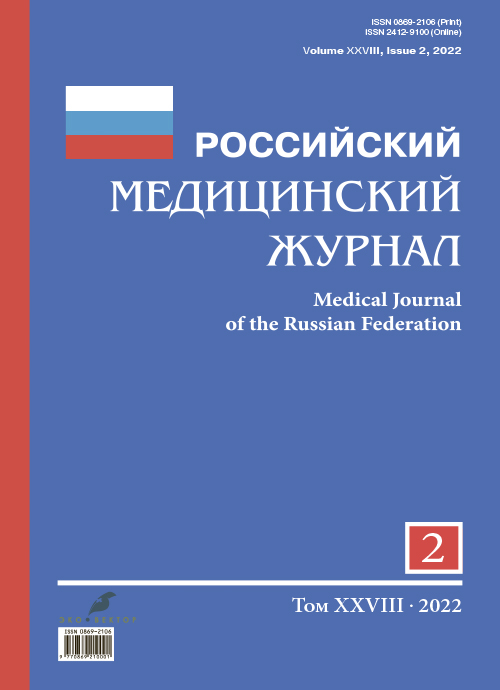A clinical case of type II bipolar affective disorder
- Authors: Osipova N.N.1, Aleschkina G.A.1, Beglyankin N.I.1
-
Affiliations:
- Evdokimov Moscow State Medical and Dental University
- Issue: Vol 28, No 2 (2022)
- Pages: 161-166
- Section: Case reports
- Submitted: 22.06.2022
- Accepted: 04.07.2022
- Published: 15.08.2022
- URL: https://medjrf.com/0869-2106/article/view/108939
- DOI: https://doi.org/10.17816/medjrf108939
- ID: 108939
Cite item
Abstract
This study presents a clinical case of bipolar affective disorder type II. Difficulties in differential diagnosis at the early disease stages are discussed. The considered clinical case reflects real psychiatric practice when the onset of the disease is identified in adolescence and associated with the impact of a traumatic situation. Disease manifestations are characterized by polymorphism and atypical affective symptoms, which require careful differential diagnosis, considering disorders of other nosological categories and pathological pubertal crisis. Early recognition of type II bipolar affective disorder is associated with difficulties in hypomanic episode identification that are not regarded by patients as painful in most cases and are not a reason for seeking psychiatric advice and care.
Full Text
About the authors
Natalya N. Osipova
Evdokimov Moscow State Medical and Dental University
Email: natinen@yandex.ru
ORCID iD: 0000-0002-8034-4457
SPIN-code: 7532-4382
MD, Cand. Sci. (Med.), Associate professor
Russian Federation, 20 Delegatskaya str., 127473, MoscowGalina A. Aleschkina
Evdokimov Moscow State Medical and Dental University
Email: aleshkina-ga@yandex.ru
ORCID iD: 0000-0001-7028-8669
SPIN-code: 7477-8598
MD, Dr. Sci. (Med.), Professor
Russian Federation, 20 Delegatskaya str., 127473, MoscowNikolay I. Beglyankin
Evdokimov Moscow State Medical and Dental University
Author for correspondence.
Email: begnik@yandex.ru
ORCID iD: 0000-0002-4638-7461
SPIN-code: 7740-2176
MD, Cand. Sci. (Med.), Professor
Russian Federation, 20 Delegatskaya str., 127473, MoscowReferences
- Psikhicheskie i povedencheskie rasstroĭstva. Klinicheskie opisaniya i ukazaniya po diagnostike [Internet]. ICD-10 [cited 2022 Jul 10]. Available from: https://psychiatr.ru/news/181. (In Russ).
- Bardenshtein LM, Slavgorodskii YaM. Mesto bipolyarnoi depressii v sovremennykh klassifikatsiyakh boleznei i problema ee raspoznavaniya. Psikhicheskoe zdorov’e. 2013;11(7):27–30. (In Russ).
- Berk M, Post R, Ratheesh A, et al. Staging in bipolar disorder: from theoretical framework to clinical utility. World Psychiatry. 2017;1(3):236–244. doi: 10.1002/wps.20441
- Van Meter A, Moreira ALR, Youngstrom E. Updated Meta-Analysis of Epidemiologic Studies of Pediatric Bipolar Disorder. J Clin Psychiatry. 2019;80(3):18r12180. doi: 10.4088/JCP.18r12180
- Crockett MA, Martínez V, Jiménez-Molina Á. Subthreshold depression in adolescence: Gender differences in prevalence, clinical features, and associated factors. J Affect Disord. 2020;272:269–276. doi: 10.1016/j.jad.2020.03.111
- Post RM, Altshuler LL, Kupka R, et al. Verbal abuse, like physical and sexual abuse, in childhood is associated with an earlier onset and more difficult course of bipolar disorder. Bipolar Disord. 2015;17(3):323–330. doi: 10.1111/bdi.12268
- Gur’eva VA. K sistematike pubertatnoi psikhopatologii. Sovremennye problemy podrostkovoi obshchei i sudebnoi psikhiatrii. Moscow: VNII obshchei i sudebnoi psikhiatrii; 1987. (In Russ).
- Mosolov SN, Ushkalova AV, Kostukova EG, et al. Validation of the Russian version of the Hypomania Checklist (HCL-32) for the detection of Bipolar II disorder in patients with a current diagnosis of recurrent depression. J Affect Disord. 2014;155:90–95. doi: 10.1016/j.jad.2013.10.029
- Ghaemi SN, Miller CJ, Berv DA, et al. Sensitivity and specificity of a new bipolar spectrum diagnostic scale. J Affect Disord. 2005;84(2–3):273–277. doi: 10.1016/S0165-0327(03)00196-4
- Hirschfeld RM, Williams JB, Spitzer RL, et al. Development and validation of a screening instrument for bipolar spectrum disorder: the Mood Disorder Questionnaire. Am J Psychiatry. 2000;157(11):1873–1875. doi: 10.1176/appi.ajp.157.11.1873
- Benazzi F, Akiskal H. Irritable-hostile depression: further validation as a bipolar depressive mixed state. J Affect Disord. 2005;84(2–3):197–207. doi: 10.1016/j.jad.2004.07.006
- American Psychiatric Association. Diagnostic and statistical manual of mental disorders: DSM-5TM. 5th ed. Arlington: American Psychiatric Association; 2013.
- Reed GM, First MB, Kogan CS, et al. Innovations and changes in the ICD-11 classification of mental, behavioural and neurodevelopmental disorders. World Psychiatry. 2019;18(1):3–19. doi: 10.1002/wps.20611
- Angst J, Ajdacic-Gross V, Roessler W. Bipolar disorders in ICD-11: current status and strengths. Int J Bipolar Disord. 2020;8(1):3. doi: 10.1186/s40345-019-0165-9
- Kazakovtsev BA, Demcheva NK, Yazdovskaya AV, Sidoryuk OV. Psikhiatricheskaya pomoshch’ naseleniyu Rossiiskoi Federatsii v 2019 godu: Analiticheskii obzor. Moscow: NMITs psikhiatrii i narkologii im. V.P. Serbskogo; 2020. (In Russ).
- Rowland TA, Marwaha S. Epidemiology and risk factors for bipolar disorder. Ther Adv Psychopharmacol. 2018;8(9):251–269. doi: 10.1177/2045125318769235
Supplementary files







